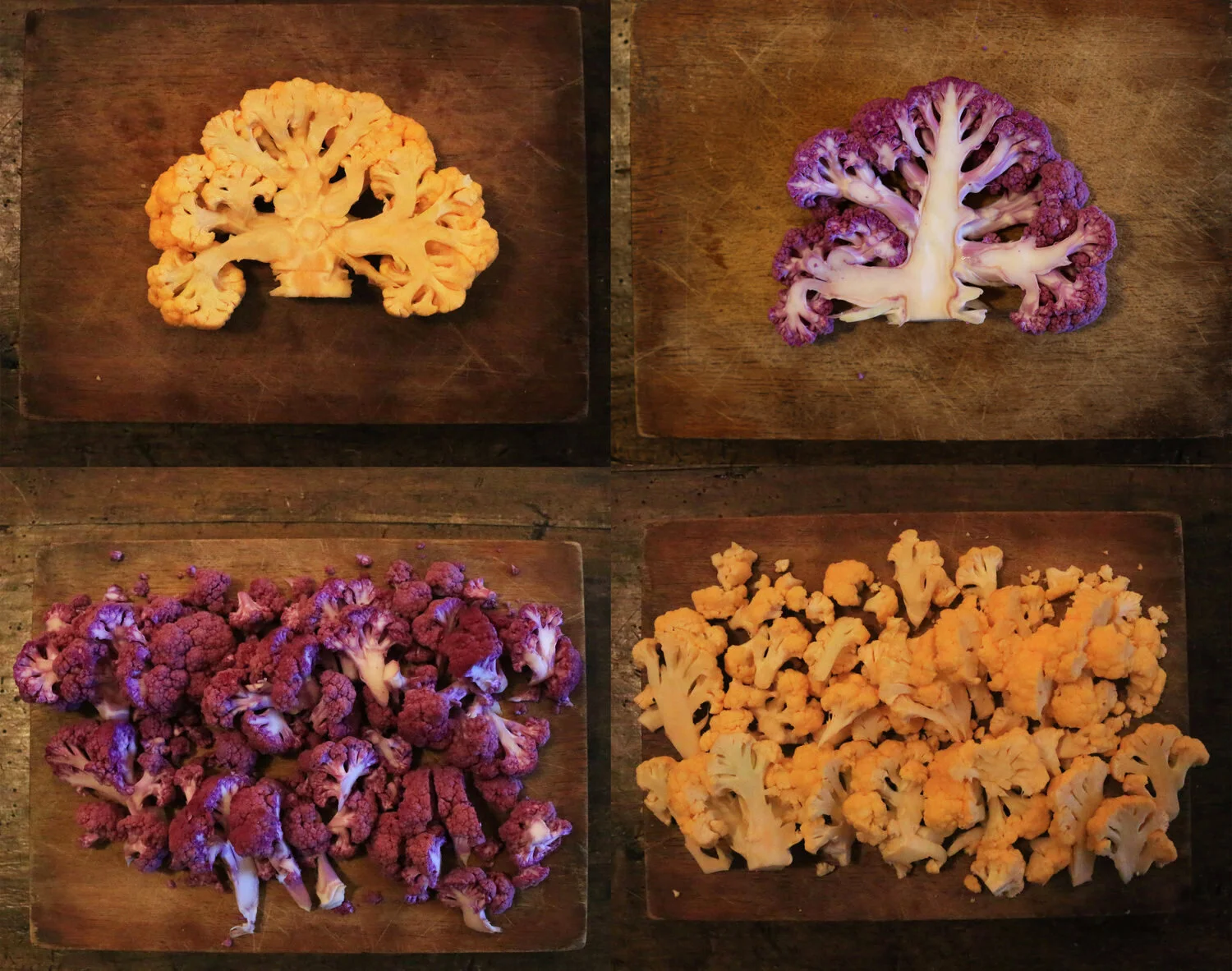Food isn’t colorful out of pure evolutionary randomness. There’s reason behind nature’s edible color coding, and the secret lies in vitamins and minerals. Red, orange, yellow, blue, purple, green and white colors signify the presence of different vitamins and minerals. Knowing how to read colors of fruits and vegetables is a great way to get familiar with the different vitamin and minerals present. Knowing the colors of nutrients is another step on the way to intuitive eating, meaning knowing how to read your food cravings to decipher what your body might be craving at that particular moment. The easiest way to assure you get in all your vitamins and minerals? Eat the rainbow!
Red: Tomatoes, watermelon, red berries and other red fruits and vegetables get their red color from the presence of lycopene, a powerful antioxidant that is believed to protect from certain cancers (prostate in particular) and strengthen the heart. They also contain vitamin C and beta-carotene (converted to vitamin A in the body) found in orange and yellow fruits and vegetables, and anthocyanin, antioxidants found in blue and purple fruits. Red fruits and vegetables are also rich in flavonoids, resveratrol, and folate. The antioxidant resveratrol is found in the skin of red grapes and is being investigated for its cancer preventive properties. Red produce also helps lower blood pressure, reduce tumor growth and LDL cholesterol levels, protects from harmful free-radicals, and supports join tissue and inflammation.
Nutrients: Lycopene, ellagic acid, Quercetin, and Hesperidia, anthocyanin, resveratrol, and folate.
Red Food Sources: Beets, Blood oranges, Cherries, Cranberries, Guava, Papaya, Pink grapefruit, Pink/Red grapefruit, Pomegranates, Radicchio, Radishes, Raspberries, Red apples, Red bell peppers, Red chili peppers, Red grapes, Red onions, Red pears, Red peppers, Red potatoes, Rhubarb, Strawberries, Tomatoes, and Watermelon.
Orange/Yellow: orangey yellow pigmented fruits and vegetables are great sources of vitamin C and beta-carotene (vitamin A) which–among their many actions in the body–are necessary for the synthesis of collagen and the reparation of skin cells. Vitamin C and beta carotene are also known for their immune boosting capabilities. Beta carotene can potentially help protect from the growth of certain cancers and vitamin A is essential for eye health. These nutrients together with the presence of zeaxanthin, flavonoids, lycopene, and potassium, also help to reduce age-related macula degeneration, lower bad cholesterol and blood pressure, protect from free radical damage, encourage alkaline balance, and work in synergy with magnesium and calcium to strengthen bones.
Nutrients: Beta-carotene, zeaxanthin, flavonoids, lycopene, potassium, and vitamin C.
Orange/Yellow Food Sources: Apricots, Butternut squash, Cantaloupe, Cape Gooseberries, Carrots, Golden kiwifruit, Grapefruit, Lemon, Mangoes, Nectarines, Oranges, Papayas, Peaches, Persimmons, Pineapples, Pumpkin, Rutabagas, Sweet corn, Sweet potatoes, Tangerines, Yellow apples, Yellow beets, Yellow figs, Yellow pears, Yellow peppers, Yellow potatoes, Yellow summer squash, Yellow tomatoes, Yellow watermelon, and Yellow winter squash.
Green: Green leafy vegetables are rich in chlorophyll as well as isothiocyanate which reduce carcinogenic agents. Green vegetables like broccoli, cabbage, and brussel sprouts also contain several other anticancer compounds and these green cruciferous vegetables are rich in Vitamin K, folic acid, potassium. These nutrients help reduce the risk of developing cancer, they protect from free radical damage, help lower blood pressure and bad cholesterol, normalize digestion time, support eye and vision health, and boost immune system activity.
Nutrients: Chlorophyll, fiber, lutein, zeaxanthin, calcium, folate, vitamin C, calcium, and Beta-carotene
Green Food Sources: Artichokes, Arugula, Asparagus, Avocados, Broccoflower, Broccoli, Broccoli rabe, Brussel sprouts, Celery, Chayote squash, Chinese cabbage, Cucumbers, Endive, Green apples, Green beans, Green cabbage, Green grapes, Green onion, Green pears, Green peppers, Honeydew, Kiwifruit, Leafy greens, Leeks, Lettuce, Limes, Okra, Peas, Snow Peas, Spinach, Sugar snap peas, Watercress, and Zucchini.
Blue/Purple: The blue/purple color of certain fruits and vegetables like blueberries, blackberries, pomegranates, and plums is due to the presence of anthocyanin. Anthocyanins are antioxidants that provide numerous protective benefits. They help fight free radicals that contribute to disease, inflammation, and early aging, and support heart health in particular. The darker the blue color, the higher the concentration of these phytochemicals. As with previous colors, these nutrients support eye health, lower bad cholesterol, boost the immune system, support healthy digestion, improve mineral absorption, fight inflammation, protect from tumor growth, and act as an anticarcinogens in the digestive tract in particular.
Nutrients: Lutein, zeaxanthin, resveratrol, vitamin C, fiber, flavonoids, ellagic acid, and quercetin
Blue/Purple Food Sources: Black currants, Black salsify, Blackberries, Blueberries, Dried plums, Eggplant, Elderberries, Grapes, Plums, Pomegranates, Prunes, Purple Belgian endive, Purple Potatoes, Purple asparagus, Purple cabbage, Purple carrots, Purple figs, Purple grapes, Purple peppers, and Raisins.
White: Vegetables and fruits devoid of colors are not devoid of nutrients. Many types of flavonoids are actually colorless and still help the body counter free radical formation. White vegetables and fruits good sources of niacin and potassium. Potassium is very important to heart health, muscle function, and balancing blood sodium levels. In addition, the presence of phytonutrients like beta-glucans, EGCG, SDG, and lignan’s boost the immune system. These nutrients also activate natural killer B and T cells, reduce the risk of colon, breast, and prostate cancers, and balance hormone levels, and reduce the risk of hormone-related cancers.
Nutrients: Beta-glucans, EGCG, SDG, lignin's, niacin and potassium
White Food Sources: Bananas, Brown pears, Cauliflower, Garlic, Ginger, Jerusalem artickoke, Jicama, Kohlrabi, Mushrooms, Onions, Parsnips, Potatoes, Shallots, Turnips, White Corn, and White peaches.


